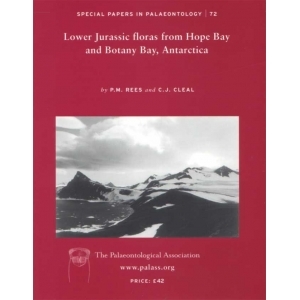
Special Papers in Palaeontology: 72
<br />2004
<br />
<br />Lower Jurassic floras from Hope Bay and Botany Bay, Antarctica
<br />P.M Rees & CJ Cleal
<br />
<br />ISBN: 0-901702-83-8
<br />
<br />90 pp; 20 pls; 9 figs
<br />
<br />ABSTRACT. Hope Bay and Botany Bay, Graham Land, Antarctica have yielded two of the most diverse floras known from the Jurassic. Because of its high diversity, as well as its early discovery and description (by T. G. Halle in 1913), the Hope Bay flora has served as a taxonomic standard for studies of other Mesozoic floras from Gondwana. This paper presents a major revision of the Hope Bay flora, based on extensive subsequent collections. A nearby flora from Botany Bay is described for the first time. Thirty-seven species are now recognised in the Hope Bay flora and 32 from Botany Bay. The floras are closely similar; 80 per cent of the Botany Bay species also occur at Hope Bay. They are shown here to be Early Jurassic, which contradicts the results of previous studies that suggested a Late Jurassic or earliest Cretaceous age. The revision of their age has special significance for our understanding of the Mesozoic geological history of the Antarctic Peninsula. It also highlights the need for reappraisal of a number of other Mesozoic Gondwanan floras that had been dated mainly on their close similarity to the Hope Bay flora. The taxonomic work has resulted in establishment of a new combination, Taeniopteris taeniopteroides, and emendation of the diagnoses of Cladophlebis oblonga, Sphenopteris nordenskjoeldii, Sphenopteris pecten and Komlopteris indica.
<br />
<br />KEY WORDS: Jurassic, palaeobotany, leaf impressions, Antarctica.